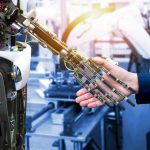 It’s a strange paradox of our times that we are repeatedly told that AI and automation will destroy jobs, whilst at the same time most of the western world is struggling with incredibly low levels of productivity growth. A recent study led by Stanford University suggests that the failure of AI investments to pull through into higher productivity numbers might be down to the economic model that underpins how companies get their data.
It’s a strange paradox of our times that we are repeatedly told that AI and automation will destroy jobs, whilst at the same time most of the western world is struggling with incredibly low levels of productivity growth. A recent study led by Stanford University suggests that the failure of AI investments to pull through into higher productivity numbers might be down to the economic model that underpins how companies get their data.
It suggests that by not paying us for the data we freely give up to Google, Facebook et al, it tends to result in poor quality data that therefore makes it harder to derive useful insights from. It’s an interesting angle, but whilst I can empathize entirely with the desire to re-align society so that the data we provide can be monetized, it’s harder to see the financial inducement that can encourage us to share more accurate data on Facebook.
An alternative argument is provided by a recent paper from Accenture. It suggests that rather than being replaced by AI, more and more roles will need us to work effectively with AI.
As with previous work, the report predicts a range of new jobs will emerge that will involve intensive work with AI-based tools. They break these roles into three main types:
- Trainers – who help computers learn and become smarter.
- Explainers – who interpret the results produced by the computers to improve the transparency and accountability of their decisions.
- Sustainers – who will ensure that the AI systems stay true to their original purpose and don’t move into unethical territory.
Taking a systemic approach
The report goes on to argue that organizations need to take a systemic approach to ensuring the interaction between man and machine is a smooth one.
“The principle is to move the spotlight from jobs to the nature of the work itself, before preparing workers with the necessary skills,” the report says.
They advocate doing this in three main steps:
- Assess tasks and skills – It’s common for organizations to have a good understanding of the job roles present within them, but it’s much less common for them to have a good understanding of the tasks and skills performed within those jobs. This is crucial as there will be new tasks that need to be performed to fully capitalize on the power of AI.
- Create new roles – As AI advances, it will enable employees to take on higher value work. This will require new roles that are driven more by insight and strategy than mono-skilled, repetitive work. It’s also likely that jobs will become specialized as we get to grips with big data and the ability it gives us to provide personalized service to customers.
- Map skills to new roles – The final step is then mapping the new skills your organization requires and the newly defined roles you created in the previous step with the skills your organization possesses. Sometimes this skills gap can be addressed by short-term contractors, sometimes it will require training programs to be offered to staff.
“It is becoming clear, however, that as people and intelligent machines begin to collaborate in entirely new ways, business leaders will have to pivot their workforce not just once, but twice. The second and truly transformational shift may be less than a decade away in some sectors. In the meantime, business leaders must make a more immediate pivot to take full advantage of the opportunities human-machine collaboration presents now, which can create the springboard to entirely new future growth opportunities and market disruptions.” the report concludes.
New skilling
I’ve written before about the challenges inherent in helping people develop the skills required to thrive alongside autonomous tools, with employers reducing spending on training at a time when newer platforms are struggling to reach those who could benefit the most.
Accenture urge organizations to renew their emphasis on training (or new skilling as they call it) to overcome a gap that sees just 3% of executives spoken to by the company planning to increase spending on training, despite roughly half of them revealing skills shortages.
They advocate prioritizing particular skills based upon the ‘skills audit’ conducted previously, and then target training so that it effectively serves people at not only different skill levels but also different levels of the organization.
The company are largely optimistic about the future of work and the impact AI will have on the workplace. Whilst the technology will fundamentally change the nature of value creation, it will do best when humans are trained and equipped to work effectively alongside the machines. Indeed, the paper suggests that most employees they spoke to were actively looking forward to having new AI-driven tools to help them do their jobs more effectively.
For this collaborative future to unfold however, organizations will need to step up to the mark and provide the resources required to ensure employees have the skills required. Time will tell whether that materializes.